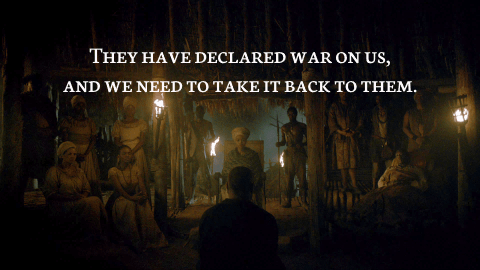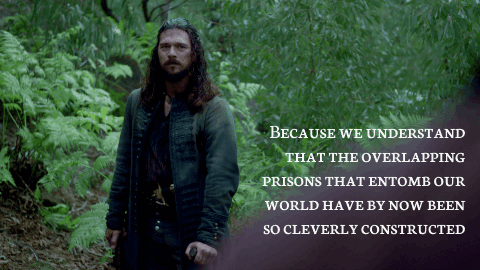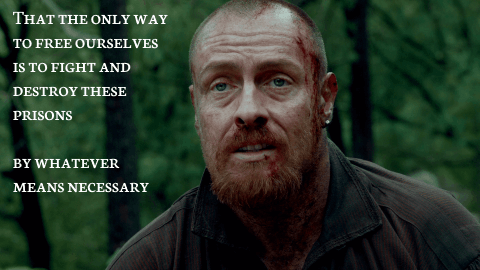#Peter Gelderloos
Text
Every single state created after a revolution by a socialist or communist Party has resulted in a continuation of capitalism. Often, the Communists were more successful than the capitalists at implanting capitalism in “less developed” countries like Russia and China (“less developed” being a phrase that is equally coherent coming from a Party bureaucrat or an IMF technocrat).
In the USSR, already in the early 1920s the Party abandoned its limited attempts to abolish capitalism. Lenin himself admitted that what they had created was a form of state capitalism. They had also destroyed much of the broader anticapitalist movement. In 1918, the Bolsheviks killed and jailed hundreds of anarchists in Moscow to stop them from carrying out expropriations and other attacks against the local bourgeoisie. In order to keep their grasp on power, the Bolsheviks at various moments needed to ally with the bourgeoisie, showing once again that no matter the color of one’s flags, the calculations of statecraft remain the same.
— Peter Gelderloos
538 notes
·
View notes
Text

On January 20, 2009, a general strike began in the French colony of Guadeloupe. After a month of fruitless negotiations, the strikers “began rioting, burning cars and businesses, throwing rocks and eventually opening fire on the police.”
After three days, the French president conceded to all 20 of the strikers’ demands. You can read more on how this played out in our book The Failure of Nonviolence by Peter Gelderloos
#Guadeloupe#french colony#french#general strike#antiwork#anti slavery#strike#riots#riot#class war#france#The Failure of Nonviolence#Peter Gelderloos#antifascist#antifaschistische aktion#anarchism#anarchist#anarchocommunism#anarchopunk#anarcho syndicalism#anarchofeminism#eat the rich#eat the fucking rich#antiauthoritarian#antinazi#workers solidarity#workers#workers of the world unite#workers rights#ausgov
146 notes
·
View notes
Quote
Some people oppose capitalism on environmental grounds, but think some sort of state is necessary to prevent ecocide. But the state is itself a tool for the exploitation of nature. Socialist states such as the Soviet Union and People’s Republic of China have been among the most ecocidal regimes imaginable. That these two societies never escaped the dynamics of capitalism is itself a feature of the state structure — it necessitates hierarchical, exploitative economic relationships of control and command, and once you start playing that game nothing beats capitalism.
Peter Gelderloos
268 notes
·
View notes
Text
“In the mainstream conversation around climate change, the most optimistic proposal suggests achieving carbon neutral economies by 2050, which supposedly could keep the temperature from rising more than 2°C. What changes could we expect to see in that most optimistic scenario?
The millions of yearly deaths discussed above would increase as clean water becomes scarcer, droughts and extreme weather events multiply, and desertification spreads. Somewhere around 25 percent of species could go extinct.20 To name just one of the many precious ecosystems that will suffer collapse, 99 percent of coral reefs will die off, leading to the loss of 25 percent of marine species and the livelihoods of 500 million people.21
It will be a world rocked by extreme, deadly heat waves breaking all previous records. The land area subjected to extreme summer heat will quadruple.22 By 2050, the land that 150 million people live on will be reclaimed by the sea, and the land that 300 million people live on will be below the level of annual coastal floods, destroying coastal cities around the world.23 Further rises in sea level would probably be locked in over the following centuries.
This is by no means a rosy picture. Nonetheless, governments, NGOs, and scientific institutions around the world are banking on this scenario as an acceptable level of collateral damage. It is no wonder that the breathless chorus of mainstream voices cheerleading the optimistic goal of going “carbon neutral by 2050” rarely discuss the extreme suffering and devastation that actually accompany their chosen timeline. City governments around the world run web pages touting their “Smart City” plans for public transportation, ride shares, and green energy. Think tanks and NGOs try to whip up enthusiasm for the few politicians who have actually committed to the goal. And barely any of them mention what that rosy scenario means for the planet and its people.
Yet it’s even worse than that. There is no guarantee that going carbon neutral by 2050 will actually function as the meager containment wall it is being sold as. Scientific predictions relating to climate have consistently underestimated the intensity and timeline of projected changes.24 To name just one example, a summer heatwave in Alaska in 2019 led to a massive salmon die-off. The science director for a local watershed non-profit spoke about a climate model they had prepared just three years earlier, that included moderate and pessimistic scenarios. “2019 exceeded the value we expected for the worst-case scenario in 2069,” she told the media.25
Runaway warming might be caused by a number of feedback loops that are already reaching their tipping point. When the IPCC first introduced the concept of climate tipping points two decades ago, they believed that no such tipping point would be triggered shy of 5°C of warming. Now they recognize that many tipping points can be triggered with just one or two degrees of warming, and there is in fact evidence that some have already begun.26 These include the collapse of ice sheets, which would substantially decrease the portion of the earth’s surface that reflects solar radiation back into space. As the polar regions warm at an accelerated rate, arctic permafrost is beginning to thaw. This has the potential to release a huge amount of methane, a greenhouse gas roughly thirty times more potent than carbon dioxide. Boreal forests in Siberia and North America are also falling victim to warming through more frequent forest fires and insect plagues. The massive tree and soil die-off means the release of more CO2.
The Amazon rainforest, currently home to one in ten species on the planet and absorbing 600 million metric tons of carbon a year,27 is in danger of turning into a giant savanna, or even a desert. Droughts caused by warming, together with deforestation for commercial agriculture, work together to take their toll. The estimate is that when the Amazon loses between 20 and 40 percent of its forest cover, the entire ecosystem will collapse.28
Warming in the oceans is causing the slowdown of Atlantic currents that are vital to the transfer of heat and nutrients that form the basis of marine ecosystems, as well as much of the planet’s weather. This could exacerbate droughts in Africa’s Sahel region and in the Amazon, and would even disrupt the East Asian monsoon, which means the collapse of more habitats, and more suffering for humans and other forms of life.29
The implication is that even if we stop all greenhouse gas emissions today, there may be natural processes under way that force a shift to a new dynamic equilibrium, a “hothouse” planet unlike anything nearly all species alive today have evolved to survive.
What might that look like? A 4.5°C rise in temperature could mean 50 percent of species would go extinct, and that’s only in a short-term analysis.30 By the end of the century, 1 billion people would be displaced and hundreds of millions would fall victim to famine. Fifty-five percent of the world’s human population would suffer more than 20 days of lethal heat a year; it’s more than a hundred days a year in the middle latitudes. Between scorching conditions and the collapse of insect populations, crop yields could decrease by a fifth or more.31 It’s no wonder that even the World Bank says that 4°C of warming might be “beyond adaptation” for human civilization.32 The hot period could easily last 200,000 years.33
As we shall see, the experts cannot solve this problem, and they have already wasted valuable decades. The subtext to the official conversation belies a staggering apathy. We will not be the ones to die. All those who disappear, human and otherwise, are an acceptable loss. We will come out on top.
For many people—especially among policy makers and experts—there is a truth to that mindset, at least for now. The millions of human deaths caused by the ecological crisis every year are not shared equally. Most of them occur in the Global South
However, while the semantic distinction between Global North and Global South is useful, many of the same processes occur in both places; the world is not as divided as those on top want to believe. For example, though the 60,000 people killed on average every year by extreme weather events mostly live in the Global South, so-called wealthy countries are not immune. The 2003 heat wave in Europe, for example, led to 70,000 excess deaths. Needless to say, few of them were living in the houses of the wealthy, with their high ceilings and air conditioning. And while 92 percent of pollution-related deaths occur in low- and middle-income countries, 800,000 people die every year from air pollution in Europe and 155,000 die every year in the US.34 Still, even these deaths are unevenly distributed. Not many rich people live near industrial parks and toxic waste dumps.
In settler states like the US, Canada, Australia, and Argentina, class is largely inscribed by the historical legacy of colonialism, with the descendants of enslaved Africans and Indigenous peoples subjected to conditions that the global distribution of wealth and power usually reserves for the Global South. When Hurricane Katrina descended on New Orleans in 2005, killing 1,800 people, anyone paying attention saw that the way infrastructure was built in poor and Black neighborhoods left people vulnerable, whereas infrastructure in wealthy white neighborhoods was designed to protect people. And contrary to the spontaneous initiatives of mutual aid that constituted the primary life saver, with neighbors helping neighbors survive the storm, and ex-Black Panthers and anarchists setting up the first on-site clinic,35 government responses focused on shooting neighbors trying to take clean water or diapers from supermarkets, and then making sure that only middle-class and wealthy residents could return to the city, “gentrification by God.” As Neil Smith wrote in the aftermath of that storm, “there is no such thing as a natural disaster.”36 The disaster was produced and directed by economic and political structures.
Those who currently hold power in our society, those who have failed us tragically, do not have our interests at heart, nor those of the planet. And in fact, our interests and the interests of the earth are one and the same. We do not know how disastrous these next decades will be. But there is one certainty that can give us hope and courage: there is not a single scenario in which taking action, in defense of ourselves, in defense of one another, in defense of all the interconnected life on this planet, will not make things better.”
- Peter Gelderloos, “ The Solutions are Already Here”
277 notes
·
View notes
Text
In the mid-19th century, socialism and communism were largely synonymous, and as often as not they referred to the dream of a future without all the institutions at the service of bankers, landlords, and factory owners; a future without the State. Since Marxism crowded out the utopian variations of socialism, however, the term has come to refer to the authoritarian shift in the international anticapitalist movement.
[...] This brings us to their primary weaknesses, which, ironically, are also interrelated and also connected to their class and subjective relationships to the workers’ movements that they did more to weaken and destroy than the police agencies of most contemporary governments.
All of their hypotheses about causation and order—where these oppressions come from, how they will change, how to change them—are worse than trash. They are either phrased in a way that is pseudo-scientific and untestable, which helps explain why Marxism has held increasing appeal among leftwing cults the more Marxist experiments proved to be real life failures (cults thrive on pseudo-sciences). Or, their affirmations about the future of capitalism and how to change it that were phrased in a falsifiable, testable way have all proven dreadfully wrong. Exactly as their anarchist contemporaries predicted.
[...] Many of us, perhaps most of us, will not get another chance for a revolution, for creating a world meant for life and not for the extraction of profit and power. We had a real shot a century ago, and we blew it. Since then, the hour has grown very late. Despite this, or likely intoxicated by the sense of urgency, many of us have forgotten our history and are turning again to the false promises of the State, in the forms of progressive, charismatic politicians, ecosocialism or eco-Leninism, the Trotskyist or Stalinist sects that have begun proliferating again, or the crypto-authoritarianism of the latest new cult of grad students who think they know better."
[...] It’s not too late, though. To recover our memory of generations of struggle. To learn from our recent setbacks. To discover ways to help as many of us as possible to survive the inferno that capitalism has become. The State is a machine for controlling and exploiting a society. It has no other function, any more than a car can grow strawberries or make milkshakes.
But communities of living beings acting in solidarity? No one is better positioned to define survival and to achieve it. Survival, and life, and joy, and healing.
#i know this is from june but i only just now got around to reading it#one of my main takeaways is that he seems to be saying that the term 'socialism' has essentially been rotted out by State socialisms#and that the things implied by 'socialist' in the mid-19th century are nowadays better encompassed by the word 'anarchist'#because for most people in the world anymore 'socialism' means a Sate#anyway it was an interesting read#i love that he has a substack#peter gelderloos#anarchism
10 notes
·
View notes
Photo








[Image descriptions: A series of eight Black Sails gifs overlaid with portions of a quote. First gif: Max talking to Jack Rackham below deck in episode 4.06. The overlaid quote says “Do you think the institutions and the elite individuals who hold the power of life or death over millions give a fuck about our protests?” Second gif: Flint kneeling in front of the maroon queen in episode 3.05. The overlaid quote says “They have declared war on us, and we need to take it back to them.” Third gif: Miranda distraught and enraged in episode 2.05. The overlaid quote says “Not because we are angry (though we should be)”. Fourth gif: Flint strangling Peter Ashe, then seeing the displayed corpse of Miranda in episode 2.10. The overlaid quote says “Not to get revenge, and not because we are acting impulsively”. Fifth gif: Flint seated in a salon gazing at the copy of Meditations after arguing with Miranda in episode 2.05. The overlaid quote says “But because we have weighed the possibility of freedom against the uncertainty of shame from living under domination,”. Sixth gif: Madi talking to Woodes Rogers in his cabin in episode 4.09. The overlaid quote says “Because we realize that some people are already fighting, often alone, for their liberation”. Seventh gif: Silver standing across from Flint in the forest in episode 4.10. The overlaid quote says “Because we understand that the overlapping prisons that entomb our world have by now been so cleverly constructed”. Eighth gif: Flint’s face as he gives the “freedom in the dark” speech in episode 4.10. The overlaid quote says “That the only way to free ourselves is to fight and destroy these prisons by whatever means necessary.” End of description.]
The full quote is from How Nonviolence Protects the State, by Peter Gelderloos.
Do you think the institutions and the elite individuals who hold the power of life or death over millions give a fuck about our protests? They have declared war on us, and we need to take it back to them. Not because we are angry (though we should be), not to get revenge, and not because we are acting impulsively, but because we have weighed the possibility of freedom against the certainty of shame from living under whatever form of domination we are faced with in our particular corner of the globe; because we realize that some people are already fighting, often alone, for their liberation, and that they have a right to and we should support them; and because we understand that the overlapping prisons that entomb our world have by now been so cleverly constructed that the only way to free ourselves is to fight and destroy these prisons and defeat the jailers by whatever means necessary.
#black sails#peter gelderloos#i regret doing these as gifs instead of stills#it took so much work to get them under the file size limit#i still have much learning to do before i get fast and good at this#black sails edit#my post
134 notes
·
View notes
Text
"Men and white people are all socialized not to listen, so we need to emphasize learning how to. Those who have bought into Western civilization, who, for example, treat their smartphones with more respect than they do people around them, are never going to be able to come up with adequate, rooted answers to the question of surviving-together. Anyone who scoffs at the idea of listening to migratory birds, to forests, to mountains, have no fucking clue and will not even be capable of finding the real conversation that is providing these answers.
Here is an analytical tool that might help. What defines a person? We should consider that a person is any being with whom dialogue is possible and meaningful. Therefore a cop or a millionaire, while human, are not people. The blue jay outside my window is a person. Let’s give our attention and care to people, since if they are people we can share a world with them. Let’s aim our rage and our destructive abilities at the institutions and their loyal robots, because they will never share a world with us."
5 notes
·
View notes
Text
Anarchy Works, Chapter 3, Economy
youtube

#peter gelderloos#anarchy works#chapter 3#161#1312#anarchism#video#videos#documentary#free books#books and reading#books & libraries#bookstagram#books#book quotes#bookblr#booklr#book#free library#free book#antifa#antifaschistische aktion#antifascist#anticapitalista#anti capitalism#class war#anarchist#anarchocommunism#anarchopunk#anarchofeminism
2 notes
·
View notes
Text
1 note
·
View note
Text
Oh shit this is a lot shorter than I thought. If the quotes I rbed strike a chord for you, you can read Learning From Ferguson here.
I sure will be
(This same link is also in the quotes)
1 note
·
View note
Text
“On a technological as well as a policy level, the instruments for reducing global warming are a part of the problem, rather than the solution. Because emissions reductions are designed to enable the continuous economic growth on which capitalism is predicated, “going green” means, more than anything else, a shift from fossil fuel energy to renewable energy on a massive, industrialized scale. But renewable energies on an industrial scale are also extremely destructive.
Hydroelectric power is currently the foremost renewable energy source. Hydroelectric dams are extremely destructive to build. They require a huge amount of concrete, production of which is one of the main greenhouse gas emitters, they cause the loss of huge amounts of forest and farmland, they kill off riverine species such as salmon, they disrupt natural flooding cycles necessary to many ecosystems, and their reservoirs emit large quantities of methane.
Photovoltaic cells capturing solar energy—solar panels—frequently use toxic heavy metals such as cadmium, gallium, and lead in their construction. On a localized scale, houses in most climates could be heated, cooled, and provided with warm water through efficient design capturing solar energy. And if people were willing (and able) to alter their daily habits and limit their electricity usage, photovoltaics free of heavy metals could play a role in this. Many of the problems arise when we take the current energy economy and assume we can keep on operating in the same way, but with different inputs. To meet current energy usage, huge swathes of land would need to be appropriated, denuded, and fenced off for solar farms. And since photovoltaics are only productive during sunlight hours, we would have to construct an enormous infrastructure for energy storage and global high-voltage direct current power lines, meaning more toxic mining, more land grabbing, more energy expenditures, and more cancer and other illnesses. Solar panels also present a waste problem, as the typical panel only lasts 25 years. At current growth rates, by 2050 we could have 78 million metric tons of junk panels, and there is currently no good way to recycle them at an industrial scale.25 Andrea Brock and other researchers argue that, far from a “paradigmatic break,” solar energy “is merely the latest iteration of an industrial growth model” characterized by “undemocratic and unsustainable industrial processes, the concentration of corporate power and profits, and externalized waste and pollution.”26
Geothermal energy, aside from having a low efficiency, requires extensive drilling that can contaminate groundwater. The technology uses pentane, a highly toxic, flammable liquid. Geothermal plants release small amounts of methane and the toxic gas hydrogen sulfide, which causes acid rain. In accidents, geothermal plants can release large amounts, such as occurred at a single Hawai’i geothermal plant during a drilling blowout in 1991, in 2013 after an equipment malfunction, and later in 2018 when the plant was damaged by a volcanic eruption.27
Nuclear power is not a renewable energy, given that it expends its fuel source, uranium, though there is a huge lobby seeking to promote it. Countries began adopting nuclear energy in the first place not for its energy benefits, but because it advanced their nuclear weapons programs. Nuclear plants come with a constant risk of meltdown, releasing large amounts of deadly radiation into the atmosphere and potentially making the territory uninhabitable for millennia. In the West, pop cultural representations of the Chernobyl meltdown ascribe the disaster to Soviet incompetence, but meltdowns and near meltdowns at Fukushima, Japan, Three Mile Island, United States, and Loir-et-Cher, France, shine a light on Cold War propaganda and show that no regime is immune to disaster.
In fact, over one hundred nuclear accidents have occurred since 1952, the largest share of them in the US. But the daily, effective operation of a nuclear power plant may be even worse than a meltdown. In 2011, 75 percent of US nuclear power sites were found to be leaking radioactive tritium.28 Depleted plutonium rods have a half-life of 24,000 years, which, for reference, is far longer than agriculture or wheels have existed, more than 40 times longer than the longest lasting state survived, and roughly 500 to 1000 times longer than your typical nuclear storage site goes without experiencing a major leak. Nuclear proponents argue that the rods constitute a small volume of toxic material compared to mine tailing from coal production, for example. They tend to leave out the millions of tons of radioactive uranium mine tailings (11 million tons from a single site in Utah) and the 1.2 million metric tons of depleted uranium produced by uranium enrichment.29 This radioactive byproduct has a half-life of 4,400 million years (or, roughly the current age of the Earth). Inexcusably, those who developed nuclear technology invented no way to safely store all that waste for the amount of time it will pose a lethal danger to all life, and no such storage technology is even on the horizon. Many nuclear waste storage facilities have been found to leak radioactive compounds into the environment.“
- Peter Gelderloos, “ The Solutions are Already Here”
131 notes
·
View notes
Text
You're Not Invited to Our Molotov Cocktail Party
Does it make sense to torch military enlistment offices? The short answer is no. And here’s why not.
From the outset of the mobilization in Russia, military enlistment offices have been targeted by arson attacks. We realized that this appears striking and effective and may seem like a good way to voice your protest. But is this really the case? Let’s unpack it.
1. It is ineffective. Most often,…

View On WordPress
#Alexei Gorinov#Alexei Rozhkov#Armen Aramyan#Bogdan Ziza#Combat Organization of Anarcho-Communists (BOAK)#direct action#DOXA (Russian student magazine)#George Losev#Igor Stomakhin#Ilya Farber#Ilya Yashin#Ivan Astashin#military recruitment offices (voenkomat)#Molotov cocktails#Peter Gelderloos#political violence#Russian anti-war movement#Russian invasion of Ukraine#Simon Pirani#Vesna Movement#Vladimir Rumyantsev
0 notes
Text
The problem with the “believe science” slogan is that it presents scientific research as a neutral, harmonious process. Critiquing science as it exists today—the web of institutions, funding and employment opportunities, and research agendas inseparable from the cultural priorities and prejudices of those who design them—is not a rejection of empirical knowledge production or any conceivable iteration of scientific institutions that might exist in alternate universes. It is a way to unmask the mythology that presents science as a pure synonym for knowledge and to talk about what is actually happening right now, and what needs to happen.
Peter Gelderloos, The Solutions are Already Here
2K notes
·
View notes
Text
Since it's been a while since I sang the praises of my favorite book 'Anarchy Works' by Peter Gelderloos: here's a reminder that there is an easy to read anarchism book out there organized around frequently asked questions and it's online for free with the authors consent. I'll copy-paste them all just to showcase how great it is:
Introduction
Anarchy Would Never Work
What exactly is anarchism?
A note on inspiration
The tricky topic of representation
Recommended Reading
1. Human Nature
Aren’t people naturally selfish?
Aren’t people naturally competitive?
Haven’t humans always been patriarchal?
Aren’t people naturally warlike?
Aren’t domination and authority natural?
A broader sense of self
Recommended Reading
2. Decisions
How will decisions be made?
How will decisions be enforced?
Who will settle disputes?
Meeting in the streets
Recommended Reading
3. Economy
Without wages, what is the incentive to work?
Don’t people need bosses and experts?
Who will take out the trash?
Who will take care of the elderly and disabled?
How will people get healthcare?
What about education?
What about technology?
How will exchange work?
What about people who don’t want to give up a consumerist lifestyle?
What about building and organizing large, spread-out infrastructure?
How will cities work?
What about drought, famine, or other catastrophes?
Meeting our needs without keeping count
Recommended Reading
4. Environment
What’s to stop someone from destroying the environment?
What about global environmental problems, like climate change?
The only way to save the planet
Recommended Reading
5. Crime
Who will protect us without police?
What about gangs and bullies?
What’s to stop someone from killing people?
What about rape, domestic violence, and other forms of harm?
Beyond individual justice
Recommended Reading
6. Revolution
How could people organized horizontally possibly overcome the state?
How do we know revolutionaries won’t become new authorities?
How will communities decide to organize themselves at first?
How will reparations for past oppressions be worked out?
How will a common, anti-authoritarian, ecological ethos come about?
A revolution that is many revolutions
Recommended Reading
7. Neighboring Societies
Could an anarchist society defend itself from an authoritarian neighbor?
What will we do about societies that remain patriarchal or racist?
What will prevent constant warfare and feuding?
Networks not borders
Recommended Reading
8. The Future
Won’t the state just reemerge over time?
What about other problems we can’t foresee?
Making Anarchy Work
Recommended Reading
It Works When We Make It Work
There, all you gotta do is click the question and read! Or start at the beginning and read the whole book if you want the best reading experience. It’s one of my favorite books. It doesn’t cover everything but it’s a great place to start.
563 notes
·
View notes
